Tamilnadu State Board New Syllabus Samacheer Kalvi 11th Bio Zoology Guide Pdf Chapter 2 Kingdom Animalia Text Book Back Questions and Answers, Notes.
Tamilnadu Samacheer Kalvi 11th Bio Zoology Guide Chapter 2 Kingdom Animalia
11th Bio Zoology Guide Kingdom Animalia Text Book Back Questions and Answers
Part I
I. Choose The Best Options
Question 1.
The symmetry exhibited in cnidarians is
a. Radial
b. Bilateral
c. Pentamerous radial
d. Asymmetrical
Answer:
a. Radial
Question 2.
Sea anemone belongs to phylum
a. Protozoa
b. Porifera
c. Coelenterata
d. Echinodermata
Answer:
c. Coelenterata
![]()
Question 3.
The excretory cells that are found in platyhelminthes are
a. Protonephridia
b. Flame cells
c. Solenocytes
d. All of these
Answer:
b. Flame cells
Question 4.
In which of the following organisms, self fertilization is seen.
a. Fish
b. Round worm
c. Earthworm
d. Liver fluke
Answer:
d. Liver fluke
![]()
Question 5.
Nephridia of Earthworms are performing the same functions as
a. Gills of prawn
b. Flame cells of Planaria
c. The trachea of insects
d. Nematoblasts of Hydra
Answer:
b. Flame cells of Planaria
Question 6.
Which of the following animals has a true coelom?
a. Ascaris
b. Pheretima
c. Sycon
d. Taenia solium
Answer:
b. Pheretima
![]()
Question 7.
Metameric segmentation is the main feature of
a. Annelida
b. Echinodermata
c. Arthropoda
d. Coelenterata
Answer:
a. Annelida
Question 8.
In Pheretima locomotion occurs with the help of
a. circular muscles
b. longitudinal muscles and setae
c. circular, longitudinal muscles and setae
d. parapodia
Answer:
c. circular, longitudinal muscles and setae
![]()
Question 9.
Which of the following have the highest number of species in nature?
a. Insects
b. Birds
c. Angiosperms
d. Fungi
Answer:
a. Insects
Question 10.
Which of the following is a crustacean?
a. Prawn
b. Snail
c. Sea anemone
d. Hydra
Answer:
a. Prawn
![]()
Question 11.
The respiratory pigment in cockroach is
a. Haemoglobin
b. Haemocyanin
c. Heamoerythrin
d. None of the above
Answer:
d. None of the above
Question 12.
Exoskeleton of which phylum consists of chitinous cuticle?
a. Annelida
b. Porifera
c. Arthropoda
d. Echinodermata
Answer:
c. Arthropoda
![]()
Question 13.
Lateral line sense organs occur in
a. Salamander
b. Frog
c. Water snake
d. Fish
Answer:
d. Fish
Question 14.
The limbless amphibian is
a. Icthyophis
b. Hyla
c. Rana
d. Salamander
Answer:
a. Icthyophis
![]()
Question 15.
Four chambered heart is present in
a. Lizard
b. Snake
c. Scorpion
d. Crocodile
Answer:
d. Crocodile
Question 16.
Which of the following is not correctly paired?
a. Humans – Ureotelic
b. Birds – Uricotelic
c. Lizards – Uricotelic
d. Whale – Ammonotelic
Answer:
d. Whale – Ammonotelic
![]()
Question 17.
Which of the following is an egg laying mammal?
a. Delphinus
b. Macropus
c. Ornithorhynchus
d. Equus
Answer:
c. Omithorhynchus
Question 18.
Pneumatic bones are seen in
a. Mammalia
b. Aves
c. Reptilia
d. Sponges
Answer:
b. Aves
![]()
Question 19.
Match the following columns and select the correct option.
| Column -I | Column – II |
| (p) Pila | (i) Devil fish |
| (q) Dentalium | (ii) Chiton |
| (r) Chaetopleura | (iii) Apple snail |
| (s) Octopus | (iv) Tusk shell |
a. p – (ii), q – (i), r – (iii), s – (iv)
b. p – (iii), q – (iv), r – (ii), s – (i)
c. p – (ii), q – (iv), r – (i), s – (iii)
d. p – (i), q – (ii), r – (iii), s – (iv)
Answer:
b. p – (iii), q – (iv), r – (ii), s – (i)
Question 20.
In which of the following phyla, the adult shows radial symmetry but the larva shows bilateral symmetry?
a. Mollusca
b. Echinodermata
c. Arthropoda
d. Annelida
Answer:
b. Echinodermata
![]()
Question 21.
Which of the following is correctly matched?
a. Physalia – Portuguese man of war
b. Pennatula – Sea fan
c. Adamsia – Sea pen
d. Gorgonia-Sea anemone
Answer:
a. Physalia – Portuguese man of war
Question 22.
Why are spongin and spicules important to a sponge?
Answer:
Spongin and spicules provide support and support the soft body parts of the sponges. The spicules give the sponges rigidity and form to the sponges.
![]()
Question 23.
What are the four characteristics common to most animals?
Answer:
- Cellular structure
- The nature of coelom ;
- Notochord
- Segmentation or absence of segmentation.
Question 24.
List the features that all vertebrates show at some point in their development.
Answer:
All vertebrates possess notochord during the embryonic stay. li is repLaced by vertebra) column. All vertebrates possess pained appendages such as fins or lunits. Skin is covered by a protective skeleton comprising of scales. fiathcrs hairs, claws, nails, etc. Respiration is aerobic through gills, skin. buccopharyngeal cavity’ and lungs. All vertebrates have a muscular heart with two, three, or four chambers and kidneys for excretion and osmoregulation.
Question 25.
Compare closed and opened circulatory system
Answer:
| Open Circulation | Closed Circulation |
| 1. There is no blood vessels | Presence of blood vessels. |
| 2. Blood remains filled in the tissue spaces. | Blood is circulated through blood vessels |
| 3. (Eg.) Arthropods, Mollusca, Echinodermata | (Eg.) Earthworm, Cephalochordates, Chordates |
Question 26.
Compare Schizocoelom with enterocoelom
Answer:
| Schizocoelomate | Enterocoelomate |
| 1. Body cavity is formed by splitting of mesoderm. | The body cavity is formed from the mesodermal pouches or archenteron. |
| 2. (Eg.) Annelids, Arthropods | (Eg.) Echinodermata Chordates |
Question 27.
Identify the structure that the archenteron becomes in a developing animal.
Answer:
The archenteron becomes the cavity of the digestive tract.
![]()
Question 28.
Observe the animal below and answer the following questions
a. Identify the animal
b. What type of symmetry does this animal exhibit?
c. Is this animal Cephalized?
d. How many germ layers does this animal have?
e. How many openings does this animal’s digestive system have?
f. Does this animal have neurons?
Answer:
a) Sea anemone
b) Bilateral symmetry
c) It is not a cephalized animal
d) Diploblastic animal
e) One
f) Yes.
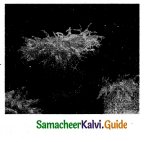
Question 29.
Choose the term that does not belong in the following group and explain why it does not belong?
Answer:
- The notochord, cephalization, dorsal nerve cord, and radial symmetry.
- Notochord, cephalization, and dorsal nerve cord are the characteristic features of chordates.
- The radial symmetry is not a characteristic feature of chordate.
- It is the feature of cnidarian and adult echinoderms. Hence it does not belong to the group.
Question 30.
Why flatworms are called acoelomates?
Answer:
The body cavity is formed from mesoderm but in flatworms, there is nobody cavity their body is solid with a perivisceral cavity.
![]()
Question 31.
What are flame cells?
Answer:
Flame cells are the specialized excretory cells in flatworms. They help in excretion and osmoregulation.
Question 32.
Concept Mapping – Use the following terms to create a concept map that shows the major characteristic features of the phylum Nematoda: Roundworms, pseudocoelomates, digestive tract, cuticle, parasite, sexual dimorphism
Answer:

Question 33.
In which phyla is the larva trochophore found?
Answer:
Trochopore larva is seen in the Phylum – Annelida.
![]()
Question 34.
Which of the chordate characteristics do tunicates retain as adults?
Answer:
Ventral and tabular heart. Respiration is through gill slits.
Question 35.
List the characteristic features that distinguish cartilaginous fishes from living jawless fishes.
Answer:
| Cyclostomata | Chondrichthyes |
| 1. Some are ectoparasites on some fishes. | They are free living. |
| 2. Body is slender and eel-like | Skin is tough and covered with placoid scales |
| 3. 6 to 15 pairs of gillslits for respiration. | Respiration is by lamelliform gills. |
| 4. Mouth is circular without jaws and suctorial. | There are lower and upper jaws. |
| 5. Migrate to freshwater for spawning | There is no migration during breeding. |
| 6. After spawning they die | They don’t die after spawning |
| 7. Oviparous | Oviparous, viviparous and Ova viviparous |
Question 36.
List three features that characterise bony fishes.
Answer:
- These fishes have a bony endoskeleton.
- The skin is covered by ganoid, cycloid or ctenoid scales.
- Gills are covered by an operculum.
- They are ammonotelic.
- They have mesonephric kidneys.
- External fertilization is seen.
![]()
Question 37.
List the functions of air bladder in fishes.
Answer:
- Air bladder may be connected to the gut or not.
- They help in gaseous exchange.
- In ray-finned fishes, they help in buoyancy.
Question 38.
Write the characteristics that contribute to the success of reptiles on land.
Answer:
- The characteristics that contribute to the success of reptiles on land are as follows:
- The presence of dry and cornified skin with epidermal scales or scutes prevents the loss of water.
- The presence of metanephric kidney.
- They are uricotelic (they excrete uric acid to prevent the loss of water).
Question 39.
List the unique features of a bird’s endoskeleton.
Answer:
- The endoskeleton is fully ossified.
- The long bones are hollow with air cavities. So that they can easily fly with lesser weight.
Question 40.
Could the number of eggs or young ones produced by an oviparous and viviparous female be equal? Why?
Answer:
No. The number of eggs or young ones produced by an oviparous and viviparous female cannot be equal. When the oviparous animals lay eggs in the external environment or in the medium, the chance of survival and successful development into the adults are not certain. But in the case of viviparous animals, young ones are nurtured by the adult animals. Hence, oviparous animals lay more eggs if they are fertilized in the medium or in water.
![]()
Part II
11th Bio Zoology Guide Kingdom Animalia Additional Important Questions and Answers
I. Choose The Best Options
Question 1.
…………………. is the first group of animals to exhibit tissue-level organization.
a. Cnidaria
b. Porifera
c. Mollusca
d. Echinodermata
Answer:
a. Cnidaria
Question 2.
Name the organs formed from ectoderm.
a. Heart
b. Hair
c. Muscle
d. Intestine
Answer:
b. Hair
![]()
Question 3.
The mesoglea seen in between the ectoderm and endoderm is present in …………………. phylum.
a. Platyhelminthes
b. Arthropoda
c. Annelida
d. Coelenterates
Answer:
d. Coelenterates
Question 4.
Inporiferans through ………………. pores water enters into the body and goes out through.
a. Osculum Ostia
b. Ostia Osculum
c. Mouth Ostia
d. Mouth Osculum
Answer:
b. Ostia Osculum
![]()
Question 5.
Choose the correct option.
a. Segmentation – Annelida
b. Archenteron – Heart Formation
c. Ostia – Sea anemone
d. Polyp Medusa – Phylum Ptenopora
Answer:
a. Segmentation – Annelida
Question 6.
Find out the correct and wrong statement and find out the correct sequence
I. In the phylum cnidaria on the tentacles nematocysts are present.
II. In evolutionary history the annelid is the first segmented animal.
III. The roundworms are diploblastic bilateral animals.
IV. The arthropods excrete through flame cells.
a. I – False, II – False, III – True, IV – True
b. I – True, II – False, III – False, IV – True
c. I – True, II – True, III – False, IV – Flase
d. I – False, II – True, III – True, IV – False
Answer:
c. I – True, II – True, III – False, IV – False
![]()
Question 7.
The organism that shows the regeneration character
a. Planaria
b. Liver fluke
c. Tapeworm
d. Leech
Answer:
a. Planaria
Question 8.
What is the excretory organ of roundworm?
a. Flame cells
b. Rennet glands
c. Green glands
d. Malphigeal tubules
Answer:
b. Rennet glands
![]()
Question 9.
The coelom of phylum Arthropoda is
a. Pseudo coelom
b. Eucoelom
c. Schizo coelom
d. Enter coelom
Answer:
c. Schizo coelom
Question 10.
Name the respiratory organ of Mollusca.
a. Ctenidia
b. Gills
c. Book lungs
d. Trachea
Answer:
a. Ctenidia
![]()
Question 11.
Name the excretory organ of Cephalo Chordata.
a. Mesonephridia
b. Metanephridia
c. Protonephridia
d. Flame cells
Answer:
d. Flame cells
Question 12.
Name the organism which has both features of chordate and non-chordates?
a. Balanoglossus
b. Ascidia
c. Amphioxces
d. Salpa
Answer:
a. Balanoglossus
![]()
Question 13.
…………………….. are called as tunicates
a. Urochordates
b. Cephalo chordates
c. Vertebrata
d. Hemi Chordata
Answer:
a. Urochordates
Question 14.
The eggs of birds are ………………..
a. Megalecithal
b. Mesolecithal
c. Telolocithal
d. Alecithal
Answer:
a. Megalecithal
![]()
Question 15.
Find the correct answer by matching.
A. Sponges – I. Mesoglea
B. Open circulation – II. Asymmetrical
C. Diploblastic animal – III. Echinodermata
D. Snails – IV. Coanocytes
a. A – IV, B -I, C – II, D – III
b. A -I, B – II, C – III, D – IV
c. A – IV, B – III, C -I, D – II
d. A – IV, B – II, C – III, D -I
Answer:
C. Diploblastic animal – III. Echinodermata
Question 16.
Find out the correct pair.
a. Planula – Planeria
b. Regeneration – Annelida
c. Trochopore larva – Cnidaria
d. Veliger larva – Mollusca
Answer:
d. Veliger larva – Mollusca
![]()
Question 17.
Which one of the following is not correctly paired?
a) Ctenophora – Veliger
b) Annelida – Trochophore
c) Cnidaria – Planula
d) Porifera – Parenchymula
Answer:
a) Ctenophora – Veliger
Question 18.
Find out the wrong statement.
a) In most animals the coelom lies between the body wall and the alimentary canal
b) In acoelomate organisms the free movement of the interval organ is restricted.
c) The cavity formed from the mesoderm is pseudo coelom.
d) If in a body cavity scattered pouches are seen then the coelom is pseudo coelom.
Answer:
c) The cavity formed from the mesoderm is pseudo coelom.
(2 marks)
II. Very Short Questions
Question 1.
What are pinococytes?
Answer:
In sponges, the outer surface is formed of plate-like cells that maintain the size and structure of the sponges are called pinococytes.
Question 2.
What are choanocytes?
Answer:
The inner layer of sponges is formed of flagellated collar cells called coanocytes. They maintain water flow through the sponges thus facilitating respiratory and digestive functions.
![]()
Question 3.
Define tissue.
Answer:
Cells that perform similar functions are aggregated to form tissues.
Question 4.
Define organ? Which was the first animal to have organ system?
Answer:
- Different kinds of tissues aggregate to form an organ to perform a specific function.
- In phylum Platyhelminthes, the organ level of organisation is first formed.
Question 5.
Differentiate between a complete digestive system from an incomplete digestive system.
Answer:
| Incomplete Digestive System | Complete Digestive System |
| 1. There is a single opening in the digestive system which serves as both mouth and anus. (Eg.) Platyhelminthes |
1. There are separate openings for the mouth and anus. (Eg.) Chordates |
Question 6.
What are diploblastic animals?
Answer:
- Animals in which the cells are arranged in two embryonic layers the ectoderm and endoderm are diploblastic animals.
- The ectoderm gives rise to the epidermis.
- The endoderm gives rise to the tissue lining the gut.
![]()
Question 7.
What is radial symmetry?
Answer:
When any plane passing through the central axis of the body divides an organism into two identical parts, it is called radial symmetry, e.g. Cnidarian.
Question 8.
What is protostomia?
Answer:
In Eumetazoans, the embryonic blastopore that develops into the mouth are known as protostomia.
Question 9.
What are deutrostomia ?
Answer:
Eumetazoans in which the anus is formed from or near the blastopore and the mouth is formed away from the blastopore are deuterostomes.
Question 10.
List the excretory organs of phylum Arthropoda?
Answer:
- Malphigean tubules
- Green glands
- Coxal glands
![]()
Question 11.
Differentiate the respiratory pigment haemoglobin from haemocyanin.
Answer:
| Haemoglobin | Haemocyanin |
| 1. It’s an iron-containing respiratory pigment. | It’s a copper-containing respiratory pigment. |
| 2. This is present in Annelida and Chordata | This is present in molluscan blood. |
Question 12.
What are the advantages of bilaterally symmetrical animals?
Answer:
The bilaterally symmetrical animals can seek food, locate mates, escape from predators and move more efficiently. These animals have dorsal-ventral sides and anterior, posterior ends, right and left sides. They exhibit cephalization with sense organs and brain at the anterior end of the animal.
![]()
Question 13.
What is cleidoic egg?
Answer:
If the female organisms lay cleidoic eggs or shelled egg then it is known as cleidoic eggs.
Question 14.
What are the extraembryonic membranes present in reptiles?
Answer:
- Amnion
- Allantois
- Chorion
- Yolk sac
Question 15.
Name the muscles that help pigeons to fly. Write the kingdom, phyllum, and class for pigeon.
Answer:
a. Pectoralis major b. Pectoralis minor
(i) kingdom – Animalia
(ii) phylum – Chordata
(iii) class – Aves
![]()
( 3 marks)
III. Short Questions
Question 1.
What are the structures formed from ectoderm endoderm and mesoderm?
Answer:
- Edoderm – Skin, Hair, Nerves, Nail, Teeth
- Mesoderm – Muscles, Bones, Heart
- Endoderm – Intestine, Lungs, Liver.
Question 2.
Name the parts A, B, and C in the diagram?
Answer:
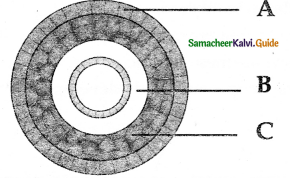
A) Ectoderm
B) Pseudo coelom
c) Mesodorm
![]()
Question 3.
Differentiate parazoa from eumetazoa?
Answer:
| Parazoa | Eumetazoa |
| 1.Multicellular | Multicellular |
| 2. Cells are loosely | Well-developed tissues arranged. and organ system is present |
Question 4.
Match
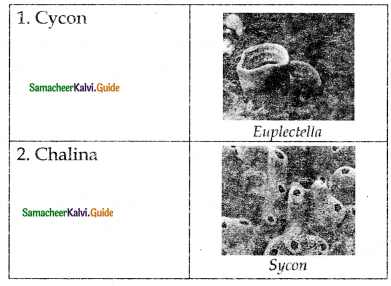
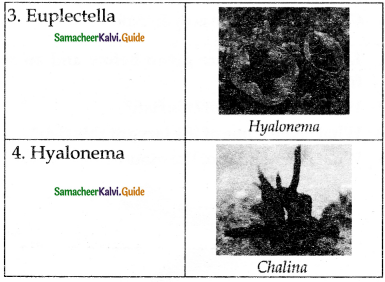
a) I – b, II – d, III – a, IV – c
b) I – a, II – b, III – d, IV – c
c) I – b, II – a, III – d, IV – c
Answer:
a) I – b, II – d, III – a, IV – c
Question 5.
Distinguish between hibernation and aestivation.
Answer:
Hibernation:
- The dormancy period for animals during winter is called hibernation.
- It is known as winter sleep.
Aestivation:
- The dormancy period for animals during summer is called Aestivation.
- It is known as summer sleep.
Question 6.
In the given diagram Balanoglossus mark A, B, and C.
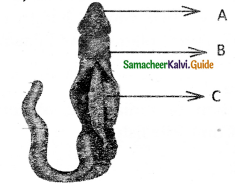
Answer:
A) Proboscis
B) Collarette
c) Genital wings
Question 7.
Give any five characteristic features of Urochordata?
Answer:
- They are exclusively marine.
- They are mostly sessile some pelagic or free-swimming.
- The body is covered by a tunic.
- The coelom is absent.
- The notochord is present only in the tail region of the larval stage.
- The circulatory system is open type.
Question 8.
Look at the picture given below and answer questions.
a) What is the name of this fish?
b) What is the name of the larva of this fish?
c) What is the shape of the mouth?
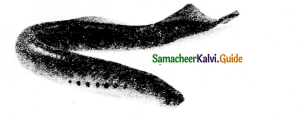
Answer:
a) iprey
b) Ammocete
c) Circular
![]()
Question 9.
What are the characteristic features of amphibia?
Answer:
- Amphibians live both in aquatic as well as terrestrial habitats.
- They are poikilothermic.
- They have two pairs of limbs.
- They may have a tail or may not be present.
- Their skin is smooth or rough.
- The heart is three-chambered.
- They excrete urea as an excretory product.
- The kidneys are mesonephric.
- They are oviparous and development is indirect.
(5 Marks)
IV. Essay Questions
Question 1.
Explain various patterns of organisation in animals.
Answer:
Animals exhibit different patterns of organisation:
The cellular level of organisation:
- Cells are loosely arranged without the formation of tissues.
- There is a division of labour among the cells, e.g., sponges.
Tissue level of organisation:
- Cells which perform a similar function are grouped into tissues.
- The tissues perform a common function, e.g., cnidarians.
Organ level of organisation:
Different kinds of tissues aggregate to form an organ to perform a specific function e.g., flatworms and other hyper phyla.
Organ system level of organisation:
- The tissues are organised to form organs and organ systems.
- All the organ system function in a coordinated manner.
Question 2.
What is coelom? Describe its types?
Answer:
Body cavity lined with mesoderm is meant as a coelom. This lies between the body wall and the alimentary canal.
1.Pseudo coelom:
The body cavity is not lined by the mesodermal epithelium and the mesoderm is formed as scattered pouches between the ectoderm and endoderm. (Eg.) Roundworm
2.Eucoelom:
The coelom is a fluid-filled cavity that develops within the mesoderm and is lined by mesodermal epithelium called the peritoneum.
3.Schizocoelomates:
In these animals, the body cavity is formed by splitting mesoderm. (Eg.) Annelids.
4.Entero coelomate:
The body cavity is formed from the mesodermal pouches of the archenteron. (Eg.) Echinodermata
![]()
Question 3.
Compare Platyhelminthes with Aschelminthes?
Answer:
| Platyhelminthes | Aschelminthes |
| 1. The body is flattened one | They are round in shape. |
| 2. They are bilateral and triploblastic animal. | They are bilateral and triploblastic animal. |
| 3. Acoelomate | Pseudo coelom is present. |
| 4. They have pseudo segmentation | The body is unsegmented |
| 5. Excretion is through flame cells. | Excretion is through rennet glands. |
| 6. Sexes are not separate. They are monoecious. |
Sexes are separate and exhibit sexual dimorphism. |
| 7. Some show regeneration capacity. | No regeneration capacity. |
| 8. Larva is present. | No larva |
| 9. (Eg.) Tape worm, Planeria | (Eg.) Ascaris |
Question 4.
Classify animals based on coelom.
Answer:
The cavity between the body wall and the gut wall is called coelom. If the animals do not have a coelom, they are called acoelomates. e.g., flatworms. In some animals, the body cavity is not fully lined by the mesodermal epithelium. The mesoderm is formed as scattered pouches between the ectoderm and endoderm. Such a body cavity is called a pseudocoel. The animals which have pseudocoel e.g. roundworms.
If the coelom develops within the mesoderm and is lined by mesodermal epithelium it is called eucoelom. The animals which have true coelom are called eucoelomates. If the body cavity is formed by splitting mesoderm, the animals are called schizocoelomates e.g., Annelids, arthropods, and mollusks. If the body cavity is formed from the mesodermal ‘ pouches of archenteron, the animals are called enterocoelomate animals, e.g., echinoderms, hemichordates, and chordates.
Question 5.
What are the characteristic features of Hemichordata?
- They possess the characters of invertebrates and chordates.
- This phylum consists of soft worm-like organisms.
- They are triploblastic coelomate animals.
- They are bilaterally symmetrical.
- Their circulatory system is simple and open type.
- They are ciliary feeders.
- Respiration is through paired gill silts opening into the pharynx.
- Excretion is through the glomerulus.
- The nervous system is primitive sexes are separate.
- In its development, there is a free-swimming to maria larva.
Question 6.
What are the general characters of the phylum Vertebrata?
Answer:
- They possess notochord during the embryonic stage only.
- The notochord is replaced by a cartilaginous or bony vertebral column in the adult.
- They possess paired appendages such as fins or limbs.
- Skin is covered by skeleton consists of scales, feathers, hairs, claws, nails.
- Respiration is through the gills skin buccopharyngeal cavity and lungs.
- The heart is with two or three or four chambers.
- Kidneys are for excretion and osmoregulation.
![]()
Question 7.
Write the general characters of the phylum cnidaria.
Answer:
- The cnidaria is aquatic, radially symmetrical, and diploblastic.
- The tentacles have stinging cells called cnidocytes or cnidoblasts or nematocysts.
- They exhibit a tissue level of organisation.
- They have a central gastrovascular cavity called coelenteron.
- Digestion is both extracellular and intracellular.
- Alternation of generation is seen in cnidarians which have polyp and medusa forms.
- Development is indirect with planula larva e.g. Physalia.
Question 8.
What are the general characters of mammals?
Answer:
- The body is covered by hairs.
- They are found in a variety of habitats.
- The presence of the mammary gland is the most unique feature of mammals.
- They have two pairs of limbs.
- The skin consists of sweat glands and sebaceous glands.
- Exo skeleton includes horns spines, scales claws, etc.
- Teeth are thecodont heterodont and diphyodont.
- The heart is four-chambered and posses a left systematic arch.
- Mammals have a large brain when compared to other animals.
- Their kidneys are metanephric and are ureotelic.
- All are homeothermic.
Question 9.
Give three distinct features of all chordates that are seen at some stage of their life cycle? What is the fate of two characters out of three in the matured adults?
Answer:
- Presence of notochord below the nerve chord and above the alimentary canal.
- The presence of the nerve cord lies above the notochord and below the dorsal body wall.
- Presence of pharyngeal gill slits in all chordates at some stage of their life cycle.
![]()
Features saw in the matured adult animals
| Larva | Adult |
| Notochord | It may be partially or completely replaced by a backbone. |
| Nerve cord | They enlarged to form the brain and spinal cord. |
Question 10.
Compare the chordates with non-chordates?
Answer:
| Chordates | Non-chordates |
| 1. Notochord is present | Absence of notochord. |
| 2. Dorsal hollow and single nerve cord | Double ventral solid nerve cord. |
| 3. Pharynx perforated by gill slits. | Gill slits absent. |
| 4. Heart is ventrally placed. | Heart indoors or laterally placed or absent. |
| 5. A post-anal tail is present | Post anal tail is absent |
| 6. Alimentary canal placed ventral to the nerve cord | The alimentary canal is placed dorsal to the nerve cord. |
Question 11.
What are the parts of ABCD in the model diagram of Chordata?
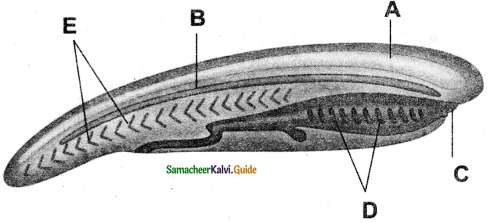
Answer:
A) Dorsal Nerve Cord
B) Notochord
C) Mouth
D) Pharyngeal gill clefts
E) Muscle segment
![]()
Question 12.
Look into the given diagram and answer the question.
a) What is the name of the organism.
b) What is the respiratory organ of this animal.
c) What type of metamorphosis is seen?
d) Whether this organism contain nerve card?
e) What is the outer covering of it’s body?
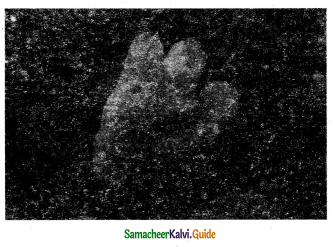
Answer:
a) Ascidian
b) Gill clefts
c) Retrogressive metamorphosis
d) The larva consists of a nerve cord.
e) Tunic